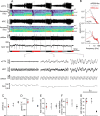State-dependent modulation of breathing in urethane-anesthetized rats
- PMID: 22895710
- PMCID: PMC6621193
- DOI: 10.1523/JNEUROSCI.0948-12.2012
State-dependent modulation of breathing in urethane-anesthetized rats
Abstract
Respiratory activity is most fragile during sleep, in particular during paradoxical [or rapid eye movement (REM)] sleep and sleep state transitions. Rats are commonly used to study respiratory neuromodulation, but rodent sleep is characterized by a highly fragmented sleep pattern, thus making it very challenging to examine different sleep states and potential pharmacological manipulations within them. Sleep-like brain-state alternations occur in rats under urethane anesthesia and may be an effective and efficient model for sleep itself. The present study assessed state-dependent changes in breathing and respiratory muscle modulation under urethane anesthesia to determine their similarity to those occurring during natural sleep. Rats were anesthetized with urethane and respiratory airflow, as well as electromyographic activity in respiratory muscles were recorded in combination with local field potentials in neocortex and hippocampus to determine how breathing pattern and muscle activity are modulated with brain state. Measurements were made in normoxic, hypoxic, and hypercapnic conditions. Results were compared with recordings made from rats during natural sleep. Brain-state alternations under urethane anesthesia were closely correlated with changes in breathing rate and variability and with modulation of respiratory muscle tone. These changes closely mimicked those observed in natural sleep. Of great interest was that, during both REM and REM-like states, genioglossus muscle activity was strongly depressed and abdominal muscle activity showed potent expiratory modulation. We demonstrate that, in urethane-anesthetized rats, respiratory airflow and muscle activity are closely correlated with brain-state transitions and parallel those shown in natural sleep, providing a useful model to systematically study sleep-related changes in respiratory control.
Figures






Similar articles
-
Spontaneous sleep-like brain state alternations and breathing characteristics in urethane anesthetized mice.PLoS One. 2013 Jul 30;8(7):e70411. doi: 10.1371/journal.pone.0070411. Print 2013. PLoS One. 2013. PMID: 23936201 Free PMC article.
-
Heat synch: inter- and independence of body-temperature fluctuations and brain-state alternations in urethane-anesthetized rats.J Neurophysiol. 2009 Sep;102(3):1647-56. doi: 10.1152/jn.00374.2009. Epub 2009 Jul 8. J Neurophysiol. 2009. PMID: 19587317
-
Cyclic and sleep-like spontaneous alternations of brain state under urethane anaesthesia.PLoS One. 2008 Apr 16;3(4):e2004. doi: 10.1371/journal.pone.0002004. PLoS One. 2008. PMID: 18414674 Free PMC article.
-
Breathing and brain state: urethane anesthesia as a model for natural sleep.Respir Physiol Neurobiol. 2013 Sep 15;188(3):324-32. doi: 10.1016/j.resp.2013.05.035. Epub 2013 Jun 7. Respir Physiol Neurobiol. 2013. PMID: 23751523 Review.
-
[Selective stimulations and lesions of the rat brain nuclei as the models for research of the human sleep pathology mechanisms].Glas Srp Akad Nauka Med. 2011;(51):85-97. Glas Srp Akad Nauka Med. 2011. PMID: 22165729 Review. Serbian.
Cited by
-
Reduced respiratory neural activity elicits a long-lasting decrease in the CO2 threshold for apnea in anesthetized rats.Exp Neurol. 2017 Jan;287(Pt 2):235-242. doi: 10.1016/j.expneurol.2016.07.020. Epub 2016 Jul 26. Exp Neurol. 2017. PMID: 27474512 Free PMC article.
-
A Respiration-Coupled Rhythm in the Rat Hippocampus Independent of Theta and Slow Oscillations.J Neurosci. 2016 May 11;36(19):5338-52. doi: 10.1523/JNEUROSCI.3452-15.2016. J Neurosci. 2016. PMID: 27170130 Free PMC article.
-
Prefrontal-Hippocampal Pathways Through the Nucleus Reuniens Are Functionally Biased by Brain State.Front Neuroanat. 2022 Jan 31;15:804872. doi: 10.3389/fnana.2021.804872. eCollection 2021. Front Neuroanat. 2022. PMID: 35173588 Free PMC article.
-
Spontaneous sleep-like brain state alternations and breathing characteristics in urethane anesthetized mice.PLoS One. 2013 Jul 30;8(7):e70411. doi: 10.1371/journal.pone.0070411. Print 2013. PLoS One. 2013. PMID: 23936201 Free PMC article.
-
The Modulation by Anesthetics and Analgesics of Respiratory Rhythm in the Nervous System.Curr Neuropharmacol. 2024;22(2):217-240. doi: 10.2174/1570159X21666230810110901. Curr Neuropharmacol. 2024. PMID: 37563812 Free PMC article. Review.
References
-
- Antkowiak B. How do general anaesthetics work? Naturwissenschaften. 2001;88:201–213. - PubMed
-
- Aserinsky E. Periodic respiratory pattern occurring in conjunction with eye movements during sleep. Science. 1965;150:763–766. - PubMed
-
- Aserinsky E, Kleitman N. Regularly occurring periods of eye motility, and concomitant phenomena, during sleep. Science. 1953;118:273–274. - PubMed
-
- Baldwin DN, Suki B, Pillow JJ, Roiha HL, Minocchieri S, Frey U. Effect of sighs on breathing memory and dynamics in healthy infants. J Appl Physiol. 2004;97:1830–1839. - PubMed
Publication types
MeSH terms
Substances
Grants and funding
LinkOut - more resources
Full Text Sources
Other Literature Sources
